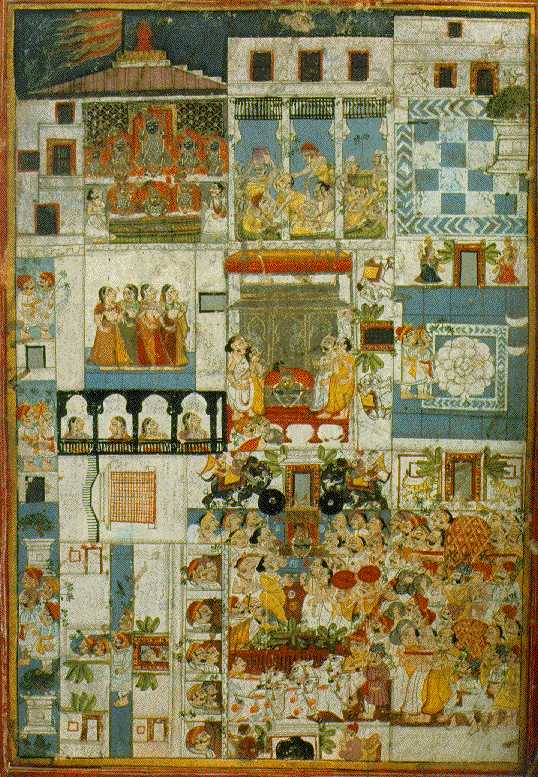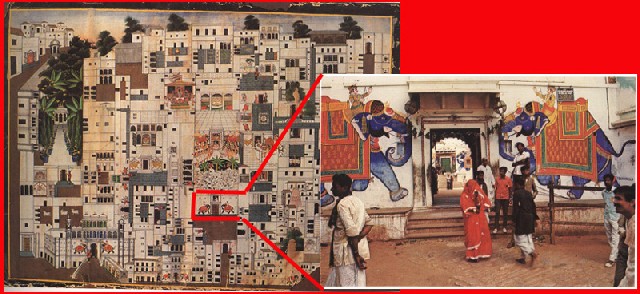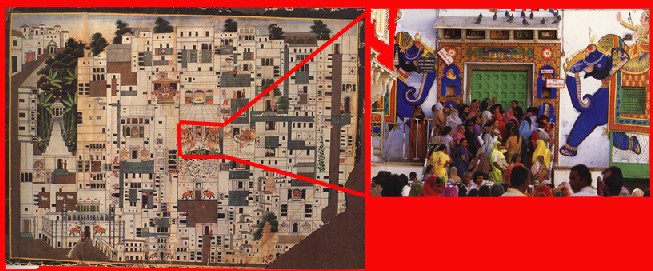
Click on an area in the painting and go to the bookmarks that describe the function of that part of the haveli. Some links will also lead to a detailed painting of that area.

We will begin our tour from the main gate and follow the natural path in to and out of the Haveli.
Nagarkhana As in the palaces of all the powerful rulers of old, the main public audiences of the prince of Nanda Bhavan are announced by a drummer and a herald.

Govardhan Chok During Divali and New Year celebrations, a miniature mount Govardhan is created in this courtyard, hence it's name. On daily basis, fruit and vegetable sellers sell their goods for those wishing to offer fresh food items to the various havelies in town. Lord's tailors sit above the chok and make new garments for the Lord on a daily basis.
Suraj Pole Lord Surya guards this Eastern gate of the Haveli. This most direct entrance to the Haveli is often referred to as the "ladies gate". As a crowd control measure, during major festivals, only women and children are allowed to go through this gate. Alternatively, men and women's gates are opened to let successive waves of devotees pass through the main audience chamber of the Lord. This is called "kheava" and at such times, the haveli stays open for as long as it takes for everyone to have at least one darshan of the Lord ! Pigeons throng to this area and are fed by the devotees every morning.

Ratan Chok Courtyard of Gems ! It is here that a Hatadi is setup during Divali. It is also the first courtyard immediately outside the Lord's inner chambers. Three gates lead into this courtyard, leading into the triple arched "hall of audience" for Shri Nathji. Apart from Suraj pole and Hathi pole, a gate also leads into here from the walled garden of Shri Nathji. Before a darshan, entrance from this gate is normally reserved for the manorathies.
Dolti Bari Main audience chamber of the Haveli. It provides a window into the wonderful world of ShriNathji. The chamber is often transformed for special festivals, such as Nauka (boat) vihar, hindolas, Tij and Dol Uttsava - hence its name - Dolti Bari (bari = window). Keeping with Rajasthani traditions, men and women are segregated during the darshan, women at the front and men at the back of the hall. To make it easier for the people at the back to have a darshan, wooden platforms of varying heights are placed from the middle to the back of the hall.
Mani Kot Ante chamber of the Lord. Singers normally sing in this chamber during darshans. During such festivals as Divali, an arch of lamps is created in here. Special guests of the Tilkayat may have their darshans from here. Only members of the Vallabh kula and special temple servants may go beyond this point.
Nija Mandir Inner sanctum of the Lord. Here the Lord resides in all his splendour. This is the heart of the Haveli and the seven flags of the Lord fly above it's tiled roof.

Anar Chok Leading out from Dolti Bari, this is the courtyard linking the kitchen and the Kamal Chok. All food for the Haveli is brought through here and often, it leaves from here to be distributed to the devotees.
Kamal Chok A large courtyard with a distinct design of a lotus in the middle, this is the main courtyard where devotees can sit and wait for their darshan. On one side, there is the Samadhan - where officials record the cash gifts from devotees (the word gift - "bhet" is used in Pushti Marg, nnever donation - "dana" for such transactions) and dispense prasad (sacrament). The courtyard has four gates, one leads to Anar chok, one to Ratan Chok, one to Dholi Patia and the Northern one leads to Pritam Pole - the Beloved's Gate - leading to the Havelii of Shri VitthalNathji.
Hathi Pole Flanked by two beautiful elephants, these silver doors lead into the Ratan Chok. Also referred to as the men's gate as during kheava, and at times when there is a large crowd, only men are supposed to enter the chok and Dolti Bari from here.
Ratan & Sing Pole After their darshan, devotees sit momentarily at this gate to contemplate the beauty of their jhakhi / vision / glimpse of the Lord. Handsome horsemen lead their painted charges through this gate and larger than life tigers guard the outer walls of this gate. A charming tale recounts how mother Yashoda had to keep the naughty Krshna from running out of the house by telling Him that if He runs out once more without his parents, the tigers guarding the Sing Pole will growl at Him !!
Dholi Patia Painted in brilliant lime white, this is the courtyard where flower sellers sell fragrant gifts which can be offered to the Lord. Seasonally, one sees such beautiful things as lotuses, jasmines, roses, champas, kevada, mogara etc. During the day, you can buy clothes and jewellery for your own seva and in the evening, painters sell paintings of ShriNathji to be put in the seva. Raised above Govardhan Chok, this is an ideal platform from which Shri VitthalNathji watches the proceedings of Govardhan Puja during the New Year celebrations.
Bhagwat Shah �
![]() Index of
information on Haveli
Index of
information on Haveli